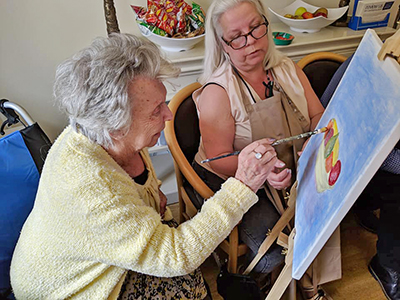Our blog has been written by Lucy Blinco, Wellbeing & Activities Coordinator at Rose Lodge Care Home in Market Deeping. Lucy completed a degree in Fine Art at the University of Northampton in 2018 and has a keen interest in Art Therapy. Lucy explains more about how the arts can be incorporated in day to day activities, bringing out the best in people in their care home.
People’s wellbeing is so much more than their physical health. Wellbeing unites the social, emotional, spiritual, environmental and intellectual aspects of a person’s life. By taking this holistic approach, the ‘Arts’ start to play an important role within care, enhancing people’s emotional wellbeing to combat stress and anxiety.
We are not just talking about painting and drawing, it is important to utilize all aspects of the arts, encompassing music, drama, cooking, dancing, and sewing. In my role as a Wellbeing and Activity Coordinator, I see how the arts have a positive impact on the resident’s emotional wellbeing every day. The arts bring joy and the ability to communicate feelings even when we can no longer communicate with words. We can use arts-based activities to create a state of reminiscence which is why it is such a powerful tool within a care setting and fundamental in our day to day activities within a care home.

What do we mean by a ‘meaningful activity’? A simple task like baking biscuits becomes a meaningful activity by allowing residents to come together and communicate their past stories, such as memories of cooking with their children. Furthermore, it engages physical exercise and sensory interaction through actions such as mixing ingredients and rolling out the dough. People can participate in this type of activity on several levels, giving someone the responsibility of reading out the recipe and instructions, for example, will give them a purpose and belonging.
I’ve seen first-hand how person-centred, tailored activities such as this, can really benefit people’s wellbeing. For example, if a resident used to be a typist then why not source a typewriter? Even if they never use it, it could trigger a host of wonderful memories and conversation around that object of familiarity

Music is one of the most powerful tools in the arts as anyone and everyone likes music. Putting on the radio or having a weekly singalong session can really enhance people’s mood. I have experienced several occasions when music can be the only form of communication. The joy is when you see a resident tapping their feet, whistling, dancing or singing their heart out because they have heard a song that they once knew. Music can be an exciting gateway to share memories and brings value to people’s past.
You may not think drama and role-play could be used in a care home setting but we often utilize aspects in reminiscence sessions. This may involve dressing up or acting out a scene from the past or an important event such as a wedding, being at school or looking after a baby. Role-play can help calm residents living with dementia and giving people the freedom to express themselves ‘in the moment’ can reduce distress and confusion. Visitors to care homes may be surprised to see dolls, pushchairs or baby’s cradles, but doll therapy can be very effective for some people.
Doll therapy is introduced sensitively by the care team for some people living with dementia, people find that they get enjoyment from holding or simply being with a doll. It might remind them of a time when they had young children of their own or simply create pleasant feelings of reminiscence, comfort, and attachment. Doll therapy may inspire a renewed sense of purpose, which can lead to increased activity levels and well-being.

Hosting events can create some wonderful memories for family members, as well as the residents. We try to capture these memories and document them in a scrapbook enabling people to look back on what they have done. At Rose Lodge Care Home we recently hosted a simple tea party for family members. Whilst drinking tea and eating cake we put our scrapbook together taking photos with a Polaroid camera which gave us instant prints and used a technology that some residents recognised as they had used it themselves in the past.
Country Court Care launched its own ‘Make A Wish’ project in 2018. The initiative gave each resident the opportunity to tell staff about something they have always wanted to do. Wishes have included going to watch their favourite football team play, hosting a dessert party or visiting a farm. Two of our residents at Rose Lodge really wanted to attend an art class, so, we did just that and invited their family members to join in too. We conducted our own art class within one of our dining rooms sourcing canvases, easels, aprons, and paint. They both really enjoyed this and with encouragement from loved ones they got into a zone of concentration for short periods of time. Looking at a bowl of fruit and seeing how they recreated that onto a canvas was very interesting because there were no boundaries, they could paint a banana purple if that is what they felt was necessary. This gave them the creative freedom to express themselves in any way they saw fit. It was more than just creating art it was about creating memories with their close family members and working as a team to communicate their feeling onto the canvas. They both created two beautiful pictures that now hold a legacy of that moment together which is very special.
Being creative in any context can really bring out the best in people. It allows their past to become the present, which can inspire a whole host of activities that bring out the best in each individual.

Lucy Blinco - Wellbeing and Activities Coordinator - Rose Lodge Care Home, Market Deeping